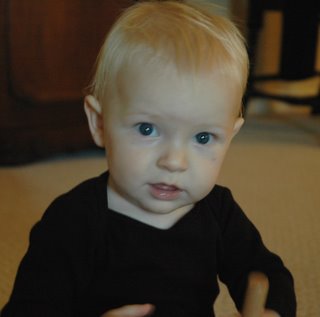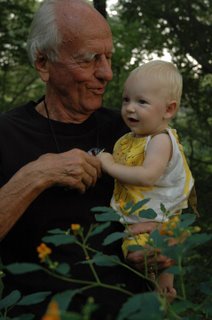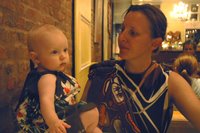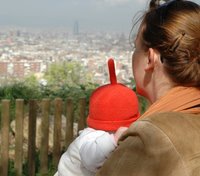
The Montessori Christmas Sweepstakes
Maria Montessori's life's work was to understand and promote the development of the whole child. She emphasized spiritual growth, grace and courtesy, independence, and the mind-body connection as pillars of the formation of the self. Her philosophy has lately come to be "method", and as such, occasionally comes nose to nose with the philosophy itself. As you all know, I'm here with the Experimental Infant (fast becoming the Experimental Toddler)trying to sort it all out. And so, I return to the whole child and her first Christmas. (Some of you remember that this was to be her second Christmas--had she deigned to be born when due...) This Christmas, Montessori had some big wins, some big losses, some laughs and some spins in her grave. To relate just a few:
The Big Loser: The Weaning Table.
Christmas (and Hannukkah, and Kwanzaa, and Eid, and Diwali and your birthday, and every other celebration I can think of) is largely expressed as dinner, and the weaning table simply misses out. It's independent, true, but it excludes her. She's a "kid's table" of one, and she seems as aware of it as I am. She just has to participate in the celebration, the passing of food, the conversation, everything. I think that her sitting at the table, eye to eye with all the important people in her life, is an invaluable social experience, and Montessori is as much about social integration of the child as it is about independence. At dinnertime, independence loses to grace-and-courtesy by a nose.
The Big Winner: Getting Outside with The Grandpa Set
Nuvy spent Christmas in Lake City, FL (we were not damaged by tornadoes, but several others were) where the highlight of her trip was pushing a plastic mower up and down the driveway until she was out of breath, dragging her bare toes on the pavement until they bled, then putting on shoes and heading out for more. No, the mower is not strictly traditional (the Radio Flyer Walker Wagon is the traditional choice--but was not available at our local Wal-Mart store) but it doesn't have bells and buzzers, and it is perfectly functional as a push toy. She's just that close to walking, and she literally came in with her tongue hanging out. There wasn't anything under the Christmas tree better than that time outside with Daddy and Gramps and the beautiful day.
 For Christmas in Philadelphia, it was a walk in the sling with Opa, over a muddy path in Fairmount Park by the Wissahickon. It's a riverside walk we take often, as it's close to home. Here again, independence loses--this time to enrichment. Sure, she might have pushed her wagon through the mud without much damage to either of them, but she would never have made it down to the rapids, or have seen the little trickle coming out of a wall, or have looked over the stone bridge. These are all of debatable developmental value compared to her independent effort in getting around in nature, and there's a big part of me that wishes I'd let her push the wagon, but the community joy was the best part.
For Christmas in Philadelphia, it was a walk in the sling with Opa, over a muddy path in Fairmount Park by the Wissahickon. It's a riverside walk we take often, as it's close to home. Here again, independence loses--this time to enrichment. Sure, she might have pushed her wagon through the mud without much damage to either of them, but she would never have made it down to the rapids, or have seen the little trickle coming out of a wall, or have looked over the stone bridge. These are all of debatable developmental value compared to her independent effort in getting around in nature, and there's a big part of me that wishes I'd let her push the wagon, but the community joy was the best part.
The Big Cringe: Another Round of Applause.
Now, I am a tremendous advocate of modeling social graces, and I want my daughter to feel loved and appreciated, but I often feel a sort of crushing guilt when I see her delightedly working the crowd.
Nuvy is an only child, and the only grandchild (until July, right, Auntie Shoogs?) of all four of her grandparents, which means that her every move is watched and recorded (yes, blogged) and cooed about and applauded. The Montessori gurus have a big bone to pick with excessively praising children, and I am right there with them. I try really, really hard to quietly beam with pride when she does something amazing, or just to share her joy in her accomplishment with a "Wasn't that great?" but it is so, so hard at family gatherings. I feel like the world's biggest stick-in-the-mud when everyone's applauding her and she's lit up like the Christmas tree. It's hard to walk the line between sharing her joy and egging her on, or trying to get her to "do it again for Uncle Mack" or whoever missed it the first time, and I can begin to see the people-pleaser in her. It's hard to resist enticing her to perform when it's so much fun for all of us, but I still get a little queasy when I remember that this is my first, best chance to let her do it just for herself.
I'll bet you want to know what was under the Montessori Baby's Christmas tree, right?
Of course you do, and it was probably a lot like Christmas morning for lots of other little American boys and girls. After all, it's not about the stuff. However, honorable mentions follow:
Best restraint in purchasing: The "baby doll that doesn't do anything". It doesn't cry, wet, sing, or play music. Its eyes do close when you lay it down. Nuvy loves it.
Best excuse for a non-Montessori toy: The battery-operated cell phone and keys. I have to paraphrase, because I can't remember the exact quote, but it goes something like this:
A: The real keys and cell phone are some of her favorite toys. B: They are not the best toys because they are (choking hazards, fragile, electronic, dirty, will-put-your-eye-out...) but she totally loves them. C: Real keys and cell phones make noises and have batteries inside. Ergo: A toy phone that beeps when you press the buttons (never mind the animal sounds) and a set of toy keys that has buttons that make car-unlocking sounds, engine starting sounds, etc. is completely within bounds as a realistic toy.
I could argue, but I won't, since it's pretty close to my audubon birds argument. Nuvy, of course, loves them.
Best toy I hid under the sofa: Leapfrog Lily. It speaks english and spanish and teaches numbers and colors in both languages. It sings a pathologically catchy song. Nuvy loves it. Please don't tell her where I hid it.
Best gift overall: I know, this one gets the corny award. She'll never remember anything anyone gave her, but I'll bet next year she'll be looking forward to Christmas. Like most of us, she won't really be able to put her finger on why, but it'll be because somewhere deep inside her is planted a memory of love and laughing and general festivity. What could be better than that?

 For Christmas in Philadelphia, it was a walk in the sling with Opa, over a muddy path in Fairmount Park by the Wissahickon. It's a riverside walk we take often, as it's close to home. Here again, independence loses--this time to enrichment. Sure, she might have pushed her wagon through the mud without much damage to either of them, but she would never have made it down to the rapids, or have seen the little trickle coming out of a wall, or have looked over the stone bridge. These are all of debatable developmental value compared to her independent effort in getting around in nature, and there's a big part of me that wishes I'd let her push the wagon, but the community joy was the best part.
For Christmas in Philadelphia, it was a walk in the sling with Opa, over a muddy path in Fairmount Park by the Wissahickon. It's a riverside walk we take often, as it's close to home. Here again, independence loses--this time to enrichment. Sure, she might have pushed her wagon through the mud without much damage to either of them, but she would never have made it down to the rapids, or have seen the little trickle coming out of a wall, or have looked over the stone bridge. These are all of debatable developmental value compared to her independent effort in getting around in nature, and there's a big part of me that wishes I'd let her push the wagon, but the community joy was the best part.
















